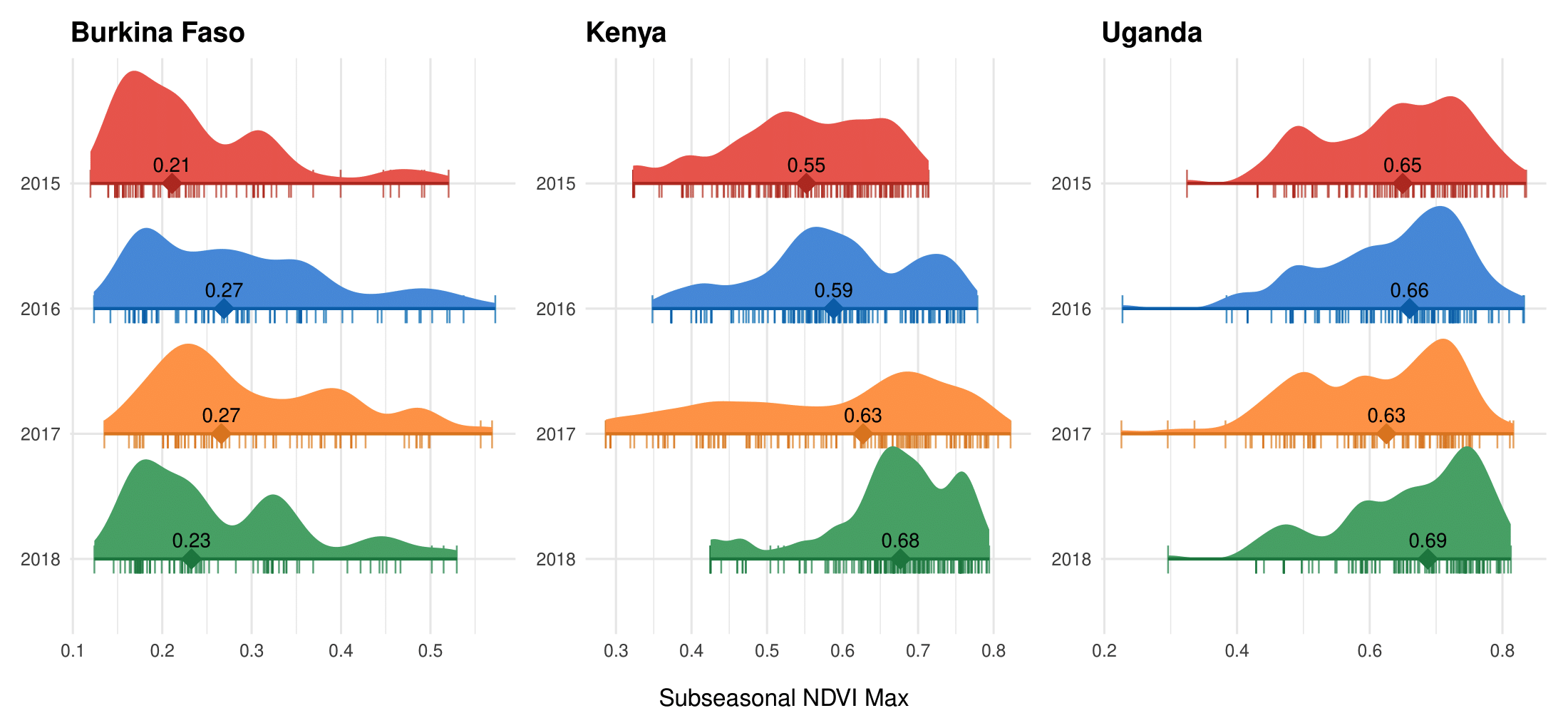Long term shifts in weather patterns have created both chronic and acute changes in growing conditions in many parts of the world. By altering food production and access, these shifts can produce long-term impacts on the lives, biology, and behavior of the subsistence farmers, agriculturalists, and pastoralist residents who rely on specific environmental conditions to support their livelihoods.
These effects are especially pronounced in low-income countries where extreme weather may have an outsize impact. Beyond merely the choices of when to plant, water, and harvest, research consistently demonstrates that growing conditions—and by extension, food access and availability—play a key role in migration decisions, livelihood selection and diversification, health outcomes, resource related conflict, and the choice of whether, when and how often to have children. Because of this, data on immediate and longitudinal growing conditions are at the heart of scientists’ understanding of the link between weather extremes and health, particularly among the most vulnerable and poorest regions and populations.
Measuring Growing Conditions
Chief among the tools for assessing immediate and longitudinal changes in growing conditions is the Normalized Difference Vegetation Index or NDVI. Developed in 1973, NDVI is based on remotely sensed imagery and is calculated using the amount of red light (which vegetation largely absorbs) and near-infrared light (which vegetation strongly reflects). The NDVI value for a given pixel of an image is the ratio of the difference between the near-infrared and red bands relative to the sum of the same two bands. This ratio provides a useful measure of vegetation quantity, density, and quality that can serve as a useful proxy for local growing conditions that takes into account the synergy between temperature and precipitation at a fine-grained spatial resolution.
On its own, NDVI provides insights into the amount of food in a location of interest—notably over time (when compared to itself) or space (when compared to surrounding regions). Figure 1 shows how the NDVI distribution varies not only across regions, but also across growing seasons within those regions—and that season-to-season differences are themselves more variable in certain regions than others. When used in conjunction with population-level data, this variability in NDVI can help researchers to understand the biological and behavioral responses to either lean periods or periods of relative abundance.

NDVI in Context
In order for NDVI to be most useful, researchers need to attend to both contextual factors and the pathways linking greenness to food production.
For example, despite providing a useful proxy for growing conditions, NDVI cannot tell us how much of a green space comprises edible crops, as opposed to cash crops, weeds and other fallow lands, or forests. As such, areas with dense vegetation may show up as having high NDVI values despite a relative lack of edible crops.
Moreover, NDVI is spatially and temporally rich, so the ways in which NDVI is aggregated and reported can have a significant impact on the degree to which NDVI values align with food production and crop yields. These decisions are context-dependent, and require knowledge of local landscapes and livelihoods. For instance, regions that are characterized by abundant natural vegetation that must be cleared to make room for cultivated consumable crops may have higher annual averages and peak NDVI—but may not yield any more food than regions characterized by lower annual or peak NDVI.
Scientists continue to develop different strategies to identify agriculture versus non-agriculture when using NDVI and strategies for this are somewhat place-dependent. The situation may also be complicated by the types of naturally occurring vegetation—yet another feature unaccounted for by NDVI. Thus, contextual knowledge is paramount to understanding the how local communities may use naturally occurring vegetation. In an ongoing qualitative study of risk and protective factors associated with acute child malnutrition in East Africa, researchers from our team interviewed field experts in Africa who reported that resilient mothers may forgo use of locally available and naturally occurring food sources in times of abundance, but would harvest those crops to buffer against hunger in lean periods (please reach out to the blog post author for more details of this research).
For an example and more detailed discussion of using NDVI for food security monitoring in rural communities, see Grace, Nagle, and Husak 2016.2
This research also highlighted the importance of understanding the biological and behavioral pathways that link greenness to conflict, health, and population outcomes. Often these pathways can work in diametrically opposing directions. In their 2023 paper on seasonal variability in NDVI and its impacts on women’s childbearing goals in three African countries, Brooks and colleagues found that higher NDVI values were associated with an increase in fertility intentions and a decrease in modern contraceptive use.1 Authors interpreted results to indicate that women changed their behaviors in response to early signals of growing season quality.
These findings echo a paper by Grace and colleagues (2017) which showed a consistent pattern under different conditions: when faced with episodes of food insecurity, women reported less desire to get pregnant, increased marital conflict, and less willingness to breastfeed.3 Yet, while high greenness may positively impact fertility aspirations (or low greenness may suppress them), research has shown that periods of abundance may also increase labor demands for women and pregnant women, leading to higher incidence of miscarriage and thus driving down fertility.4,5 Clearly, the pathways that link NDVI to various health outcomes are not straightforward, and teasing them out often requires qualitative study and stakeholder engagement.
NDVI provides an invaluable tool for understanding how extreme weather impacts food production with implications for health and health-related behaviors. Yet in order to make best use of NDVI, it is imperative to understand the decisions in measurement and quantification of local vegetation, how that relates to food production, and the pathways linking food production to biology and behavior change.
Getting Help
Questions or comments? Check out the IPUMS User Forum or reach out to IPUMS User Support at ipums@umn.edu.